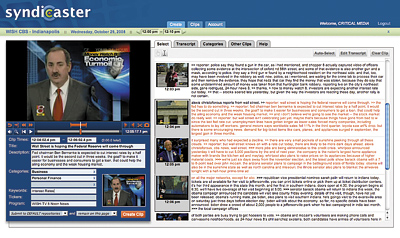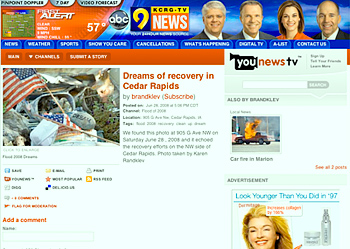Syndicaster, YouNewsTV Offer Online Alternatives

After countless exhortations to re-think "mass" media in a "class" media environment, broadcasters are finding their place in online video, and making money in the process.
Two young ventures epitomize the new give and take of online video opportunities. Syndicaster, a service that enables local TV stations to recycle their news coverage onto specialty industry Web sites, debuted in late September, after a year of beta-testing and fine tuning. YouNewsTV continues to ramp up its user-generated content contributions, with some videos making it onto the air at participating TV stations.
Both Syndicaster and YouNewsTV operate on a service bureau basis, a common practice in the early days of network computing—now expanded for the Web video era. The companies behind each venture handle almost all the technical details, including coding, hosting, serving and advertising sales for the online products. That represents more evidence of cross-platform media convergence.
These Web-based services are establishing new kinds of give and take in the broadcast world. For stations allied with Syndicaster, the goal is to give—or more pertinently sell—existing content to new and far-flung audiences. For YouNewsTV, the objective is to take—i.e., gather—content that can enhance and expand stations' Web sites and on-air programming.

Syndicaster's Web site provides content for its online network of special interest audiences.SYNDICASTER PACKAGES, SHARES CONTENT
Syndicaster is the latest offering from New York-based Critical Media Inc., which has been packaging video clips and other content for its online network of special interest audiences. Nearly 400 content providers, including more than 250 TV stations and cable news channels, currently provide video content, which Critical Media distributes to Web site publishers.
About 4,000 Web sites have registered to use this video content and share the revenue stream, according to Ion Puspurica, executive vice president and general manager of the Broadcaster Services Group at Critical Media.
The Syndicaster business model is straightforward. Stations pay a negotiated fee to use the Syndicaster platform, where their content is digitized, processed and stored. Local TV stations can create video clips from their on-air content within moments after airtime and then access it for their own purposes.
Critical Media automatically distributes the stories to the station's own Web site, to ClipSyndicate (Critical Media's vertical syndication platform) and to other distribution partners identified by the station. It also sells targeted advertising to accompany the stories. The stations (content owners) receive 30 percent of the ad revenues, and the Web sites receive 20 percent; the balance stays with Critical Media to cover bandwidth, technology, sales and overhead costs.
"Our service offers an entire media ecosystem that addresses the needs of various constituencies: content owners, publishers and advertisers," Puspurica said.
Local TV stations typically supply about 10 to 20 stories each day, all of which are tagged, using a standardized content management system. Other content partners, such as Bloomberg TV, offer more than 100 daily video reports.

More than 60,000 people are registered to upload user-generated content to stations via YouNewsTV. Group owners, including Journal Broadcast Group, Landmark Media Enterprises, Bonneville International and Sunbelt Communications, have signed up for the Syndicaster service. Using a unified taxonomy, video stories are tagged so that they go directly to appropriate Web sites. For example, a video story coded as dealing with diabetes would be matched to Web sites seeking stories about health and specific medical topics. Syndicaster generates the full text transcript from closed captions and from audio recognition software that converts spoken narratives into words that can be indexed, making every video discoverable by search engines.
Web sites receive pertinent video stories from any participating TV station content provider based on the unified content taxonomy. For example, www.wardsauto.com, the widely viewed automotive-industry Web site, uses news and feature story video clips from TV stations in its coverage of automotive industry products and services. Readers of the site—such as auto dealers and manufacturers—are entitled to download videos from www.wardsauto.com/video to their own Web sites, adding further distribution for the TV station's content.
Via Syndicaster's tracking system, any time a Web surfer looks at that video through any source, the originating TV station gets its 30 percent share of the ad revenue.
GIVING LOCAL NEWS A SECOND LIFE
Online video players are available via the 4,000 registered vertical industry Web sites, ranging from ones focused on construction, health/medical, legal and business issues to sports and hobbies. Through these primary sites, the players have been embedded on more than 200,000 Web sites. That has allowed Critical Media to build what Puspurica calls "the largest vertical video ad network online" and "help TV stations monetize their content beyond their core audience."
"It makes perishable news evergreen," Puspurica said.
While a local news story may have a 24-hour lifespan on TV or on the station's local news Web site, some local content may be of interest for months or years to special audiences, such as health researchers who want to view medical video reports or civil engineers and lawyers who want to see details about a bridge collapse, he said.
Puspurica cited a Baltimore Fox station that aired a report on a bridge collapse. The station's Web site attracted about 10,000 page views for that story, a pittance compared to the 300,000 views via Critical Media's online distribution.
Advertisers looking for rich-media relationships are signing on with Critical Media, although the company does not release its rate card or ad revenues. For example, the New York City Police Department, which is recruiting returning soldiers, bought the entire ad inventory on a military vertical channel for three months during ClipSyndicate's test phase. Puspurica says that the typical click-through rate for relevant ads on such targeted sites is 2 to 4 percent—well above the typical online ad click-through rate of about 0.25 percent.
YOUNEWSTV ENCOURAGES LOCAL CONTENT
With YouNewsTV, Broadcast-Interactive Media is exploiting the social media phenomenon. Specifically, YouNewsTV focuses on outsourcing the management of user-generated content on broadcasters' Web sites. Occasionally, some user-generated video content works its way onto the TV newscast or other on-air venues. BIM is trying to future proof its service by making sure that every Web site it hosts is enabled for mobile access, said Marivic Valencia, YouNewsTV's marketing director.
More than 60,000 people have registered to upload user-generated content to stations via YouNewsTV. Online surfers do not need to register to view the content on the stations' Web sites, Valencia said.
For example, 25 percent of the 13 million page views on the KCRG-TV (Cedar Rapids, Iowa) Web site went to YouNewsTV content, according to Valencia. That total included many Web viewers from beyond the local area—augmenting the claim that Web video enlarges the reach of the station and its advertisers.
"Viewers are willing to watch gritty videos; they accept them as more authentic," Valencia said, noting that the user-generated content experiences "teaches consumers how to appreciate" timely, community content.
About 10 to 13 percent of the user-generated content that BIM receives is motion video; still pictures are most of the other content. Valencia expects more videos to be submitted as camera phones and digital still cameras are able to store more motion video. Currently videos going on the Web site average about 30 seconds each; she concedes that it is a challenge for BIM to increase the length of videos.
YouNewsTV, launched in March 2006, is an offshoot of Madison, Wis.-based BIM's Web hosting and management service for radio and TV stations. Viewers can e-mail video or still photos from their camera phones or upload images and videos from a desktop or laptop computer. The service is now available on the Web sites of 65 TV stations, predominantly in medium and small markets, although stations in San Francisco-Oakland, Boston, Detroit and Seattle use YouNewsTV content, too. BIM has market-exclusive relationships with group owners including Fisher Communications, Journal Broadcasting Group, Schurz Communications, Meredith Corp., Freedom Communications and Granite Broadcasting.
MAKING THE CUT
BIM's staff reviews every video and photo that is submitted to assure the quality and appropriateness of all content, monitoring for violent, graphic, obscene or copyrighted material.
"We send a notice to each person about why material is rejected," Valencia said. "We handle it all; stations don't have to do anything. We deal with copyright problems. We don't edit material: just approve or reject it."
Participating stations have real-time access to all material contributed through YouNewsTV, allowing them to choose content that is worthy of on-air presentation. Valencia cites stations that have aired user-generated content for overnight breaking news stories that would not otherwise have been covered.
Last summer's horrendous flooding in the Midwest showed the power of YouNewsTV. Stations posted user-captured photos and video on their Web sites faster than the video that their news crews could shoot, according to Valencia.
The YouNewsTV package includes seven online channels, two of which the station can localize for special promotional events such as Mother's Day, Halloween or reports on local military service men and women. BIM recently concluded a year-long test with Google, using text overlays to enhance the user-generated video content. During the field trial, local TV station partners had a direct line to Google content to enhance the video they showed.
BIM sells advertising on the station Web sites that include YouNewsTV content. Rates are based on the size of the market; Valencia points out that prices are in the "hundreds of dollars per month," not thousands.
"Our next big push is video for the station," Valencia said. In September, BIM launched a "Best of YouNewsTV" series for on-air presentation, with 26 half-hour episodes scheduled for the coming year; new episodes will debut during rating sweeps. Stations may run local content in place of the national videos and photos and they may also replace the YouNewsTV host with local talent, to further customize the show for their markets.
BIM's vision for the convergence of Web and broadcast video is succinct.
"We are not a 'local YouTube,'" Valencia said. "We're cultivating a culture of quality, focusing on the stories that [viewers] are submitting."
As with Syndicaster, YouNewsTV is part of the new give and take of Web video.
Gary Arlen is president of Arlen Communications Inc., a new media research firm in Bethesda, Md. He can be reached at GaryArlen@columnist.com.
Get the TV Tech Newsletter
The professional video industry's #1 source for news, trends and product and tech information. Sign up below.
Gary Arlen, a contributor to Broadcasting & Cable, NextTV and TV Tech, is known for his visionary insights into the convergence of media + telecom + content + technology. His perspectives on public/tech policy, marketing and audience measurement have added to the value of his research and analyses of emerging interactive and broadband services. Gary was founder/editor/publisher of Interactivity Report, TeleServices Report and other influential newsletters; he was the long-time “curmudgeon” columnist for Multichannel News as well as a regular contributor to AdMap, Washington Technology and Telecommunications Reports; Gary writes regularly about trends and media/marketing for the Consumer Technology Association's i3 magazine plus several blogs.

